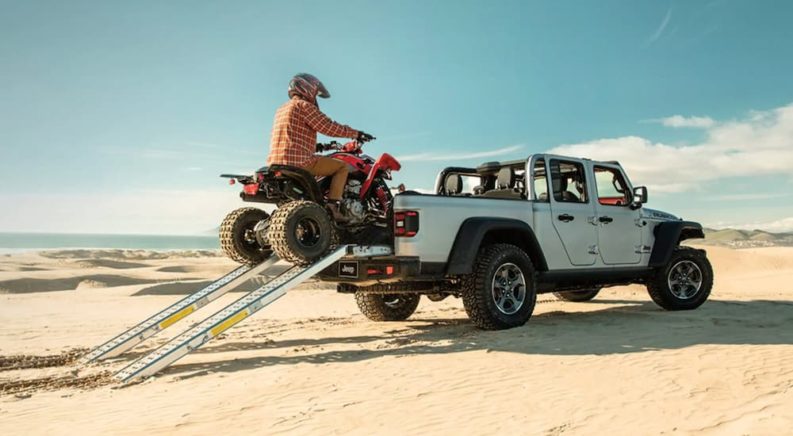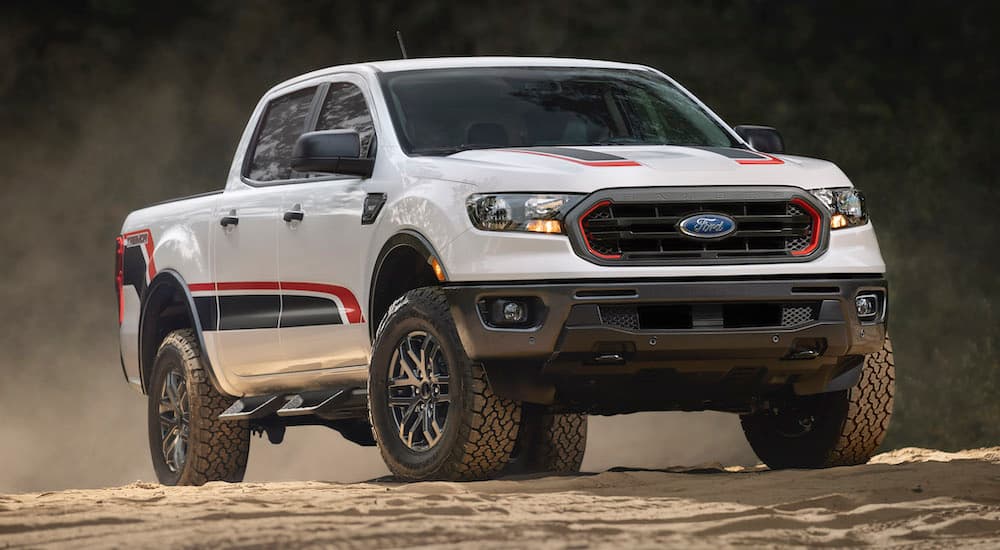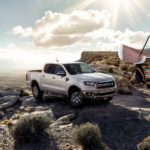The utility and functionality of a midsize pickup aren’t just how well it tows, but how well it tows, handles payload, and performs under different loads and circumstances. It’s all about what you can expect from the vehicle; what sort of features you can make use of when it comes to its bed, and how well it handles and performs on the road…or in this case, off the road as well. That leads to a comparison between the 2022 Jeep Gladiator vs 2022 Ford Ranger in the utility and functionality department.
Beyond simple performance specs, how much utility do you get out of these trucks? And specifically, how well does the Gladiator match up to the Ranger, which is considered the F-150’s little brother and is well known for being quite utilitarian across a wide number of facets? Keep in mind that this isn’t the be-all, end-all comparison between these two trucks, and your mileage (pun intended) will obviously vary depending on what you plan to use the truck for and where you intend to drive it.
Specs at a Glance
The 2022 Jeep Gladiator has a max tow rating of 7,650 lbs, with a max payload rating of 1,700 lbs. You will need the Gladiator configured with the 3.6-liter naturally aspirated Pentastar V6, with 285 hp and 260 lb-ft of torque, and the Max Tow Package to get the most out of the Gladiator’s towing capabilities. You can opt for the turbocharged 3.0-liter EcoDiesel V6, which offers 260 hp and 442 lb-ft of torque for better access to low-end torque. However, this comes at the expense of the overall tow capacity, bringing it down to 6,500 lbs due to the diesel engine upping the vehicle’s weight.
The 2022 Ford Ranger only has one powertrain in the form of the turbocharged 2.3-liter EcoBoost inline 4-cylinder. The EcoBoost delivers 270 hp and 310 lb-ft of torque. It’s also paired with a 10-speed automatic transmission. It can manage a max tow rating of 7,500 lbs and a max payload rating of 1,905 lbs. This is interesting because you have more towing capacity with the Gladiator but slightly more payload with the Ranger. An obvious give and take when it comes to overall performance figures.
However, the upside to the Gladiator is that if you opted to use it more for its bed and payload but also wanted better fuel economy out of the off-road-ready truck, the EcoDiesel is a great equalizer. This is especially relevant thanks to the EcoDiesel’s fuel economy of 22 MPG in the city and 28 MPG on the highway. The Ranger, unfortunately, doesn’t have a diesel option, so while it manages better fuel economy than the Jeep’s Pentastar at 21 MPG in the city and 26 MPG on the highway, it lags behind the Gladiator’s EcoDiesel. Another thing worth noting is that those numbers are for the Ranger configured in rear-wheel drive, while the Gladiator has four-wheel drive standard.
Bed Utility
While max tow ratings can help identify what you can tow with each midsize truck, they are only part of the tale. There’s a whole other side to a midsize truck’s capabilities when it comes to utility. Another large part of what makes a truck worthwhile is how you can use the truck’s bed, whether it be for payload, storage, as a mobile generator, or a number of other uses. In this case, the Gladiator comes standard with a five-foot bed, while the Ranger has options for a five-foot or six-foot bed.
While the extra foot in the Ranger bed might make it seem like the more functional of the two, such a hasty assumption couldn’t be further from the truth. For instance, at the outset, the Gladiator has a three-position, auto-damped tailgate. So if your hands are full and you open the tailgate on the Gladiator, it automatically dampens the gate, as opposed to the Ranger’s, which simply falls and bangs against the bumper unless you manually hold it up. This is a major win for the Gladiator because if your hands are preoccupied carrying something, you don’t have to worry about damaging the tailgate since it has auto-dampening.
External Power
Another big thing for pickup trucks is being able to use them as mobile generators. This is usually done via external power outlets available in the bed. Once again, this falls back to the utilitarian nature of a pickup being used for more than just towing and payload. For work-site purposes, you may need a truck that can easily and conveniently provide outlets for your power tools. How well do the participants in the 2022 Jeep Gladiator vs 2022 Ford Ranger showdown measure up? Well, the Gladiator measures up quite well.
You’ll have a very convenient all-weather 115-volt, 400-watt power outlet in the back of the 2022 Gladiator’s bed next to the bed hooks. This gives you a lot of leeway in what you can power externally using the Gladiator. From electric power saws and drills to flood lights, you can utilize the Gladiator’s bed to power almost all your essential tools right from the truck, giving it a lot of breadth as a mobile generator.
Unfortunately, there is no similar external power outlet for the Ranger, which greatly diminishes its ability to work as a mobile generator on work-site locations. There is only an available Bed Utility Package that adds a 12-volt power outlet to the bed for several hundred dollars. Your standard alternative would be to open up the doors and plug in your equipment through the 110-volt, 150-watt AC power outlet available in the console. Unfortunately, it just doesn’t provide the same level of power as the Gladiator, which makes the Ranger far less useful in that regard than its Jeep rival.
Cargo Management
When thinking about the utility and functionality of a pickup, it’s easy to overlook how necessary the requirement of cargo management is. Managing the cargo stored in your pickup is just as important as how much of it you can store. For instance, what good is having a high payload capacity if you don’t have simple things like tie-down hooks? Well, on the plus side, both the Gladiator and the Ranger come with cargo tie-down hooks in the bed, making them more than capable of keeping your payload secure during travels.
However, where the two midsize pickup trucks differ is in the way they can manage cargo. The Gladiator has a Trail Rail System that you can very easily use to mount, modify, and customize the way you store gear and payload in the rear of the Gladiator. There isn’t an equivalent system available for the 2022 Ranger, which once again greatly diminishes its versatility. In fact, there is no standard cargo management option for the Ranger, which is quite a disappointment. You would basically have to opt for a third-party solution.
With the Gladiator, not only do you have the Trail Rail to work with, but if you specifically need to outfit your Gladiator to carry tents, tool boxes, generators, or other equipment, there are official modular systems designed to fit right into the Gladiator’s bed. The truck has been outfitted for bespoke solutions thanks to the in-bed rail system. This is a great way to get a lot of functionality out of the Gladiator, especially with the added LED bed lights, so even if it’s dark out and you need to continue working or access your bed, you can do so in a well-lit area.
Getting More Utility Out of the Gladiator
While the Ford Ranger may offer more payload and is known to essentially be a mini F-150, it still lacks a lot of core functionality to make it as dependable as an F-150 or, in this case, a 2022 Jeep Gladiator. While the Gladiator still has a ways to go before it’s crowned king of the midsize trucks, it’s well on its way, and this is regardless of its off-road capabilities. As a practical midsize pickup, features like the HD trailer cam accessible from the center console, along with the modular open-air design and highly functional bed, all help give it a lot of credibility in the utility space. What’s interesting is that there’s a lot Ford could learn in upgrading and updating the Ranger to be more competitive in the utility space when compared to the ever-evolving Jeep Gladiator.




